A year on, there is still no accountability following the October 13, 2023, targeted Israeli attack that killed Issam Abdallah and injured six journalists in southern Lebanon
Less than a week into the Israel-Gaza war, at 6:02 p.m. on October 13, 2023, the Israeli military fired two tank shells 37 seconds apart into south Lebanon. The military’s target? Seven journalists standing on a hilltop around a mile from the closest hostilities, wearing clearly marked “Press” vests and reporting next to a car marked “TV.”
The Israeli attack instantly killed Reuters’ Issam Abdallah, a veteran video journalist with extensive experience covering conflict in his native Lebanon, as well as in Syria, Iraq, and Ukraine. Agence France-Presse (AFP) photojournalist Christina Assi, also from Lebanon, sustained injuries resulting in the amputation of her right leg. Five other journalists were also wounded: AFP’s Dylan Collins, from the United States; Al Jazeera’s Carmen Joukhadar and Elie Brakhya, also from Lebanon; and Reuters’ Thaer Al-Sudani and Maher Nazeh, from Iraq.
In March 2024, an investigation by the United Nations Interim Force in Lebanon concluded that an Israeli tank targeted “clearly identifiable” journalists in violation of international law, according to Reuters’ review of the investigation, which has not been made public. Four additional investigations — by AFP, Amnesty International, Human Rights Watch, and Reuters — all independently arrived at the same conclusion: that Israel conducted a deliberate attack on the journalists. A deliberate attack on civilians constitutes a war crime under international law.
Yet, a year later, Israel still has not confirmed if it has even completed a preliminary investigation into the attack. The North America Media Desk of the Israel Defense Forces (IDF) told CPJ in an email that the military used tank and artillery fire on October 13 to prevent a suspected “terrorist infiltration,” and the incident was “under review.” Israel has not released information about the identities of the officials who authorized or conducted the strike, leaving the survivors with more questions than answers about the attack that upended their lives and impeded their work.
A pattern of targeting
The October 13, 2023, attack was an early example of the Israeli military deliberately targeting journalists for their work after the outbreak of the war on October 7. Since then, CPJ has found that four other journalists, all Palestinians, were deliberately targeted by Israel for their reporting in Gaza. They are: Hamza Al Dahdouh, Mustafa Thuraya, Ismail Al Ghoul, and Rami Al Refee. CPJ is investigating at least 10 other cases of suspected targeting.
“In spite of extensive evidence of a war crime, a year on from the attack, Israel has faced zero accountability for the targeting of journalists.”
– CPJ CEO Jodie Ginsberg
The total number of targeted journalists is likely an undercount amid myriad challenges of documenting a war that has killed at least 128 journalists, 126 of them by Israeli fire. The number and pace of journalist killings, the large-scale destruction of media infrastructure, ongoing blackouts, and lack of independent access to Gaza for foreign media have posed hurdles to assessing the deliberate targeting of journalists for their work. CPJ has also documented a pattern of family members of journalists killed after the journalists received threats.
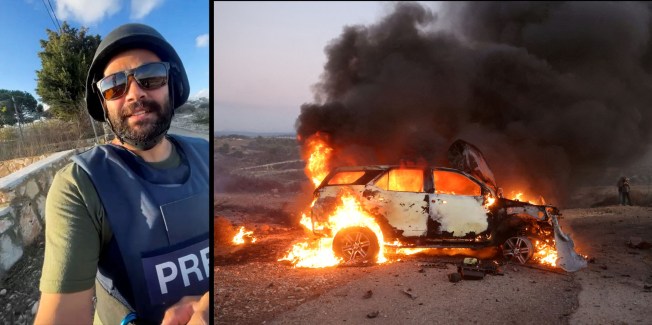 Reuters journalist Issam Abdallah (left) is seen in a selfie video image on October 13, 2023, on the day and at the site in southern Lebanon where he was killed by Israeli tank fire in cross-border strikes that wounded six others, including two Al Jazeera crew members whose car was destroyed. (Photos: Reuters/Issam Abdallah, Reuters/Thaer Al-Sudani)
Reuters journalist Issam Abdallah (left) is seen in a selfie video image on October 13, 2023, on the day and at the site in southern Lebanon where he was killed by Israeli tank fire in cross-border strikes that wounded six others, including two Al Jazeera crew members whose car was destroyed. (Photos: Reuters/Issam Abdallah, Reuters/Thaer Al-Sudani)No one has been charged or held responsible for any of these deaths, and the IDF has not disclosed whether it has opened an investigation into a single journalist killing.
The attack is part of a pattern of impunity by Israel in journalist killings. In May 2023, CPJ published a report finding that Israel had never held its military to account for 20 journalist killings over 22 years.
“The October 13 targeted attack that killed Issam Abdallah and injured six journalists clearly identifiable as press is a continuation of Israel’s decades-long pattern of targeting journalists with impunity,” said CPJ CEO Jodie Ginsberg. “In spite of extensive evidence of a war crime, a year on from the attack, Israel has faced zero accountability for the targeting of journalists. With over two decades of targeted attacks on journalists without any consequences, the Israeli military has been granted license to continue this deadly pattern.”
A large body of evidence from a harrowing day
In contrast to Gaza, where independent access has been severely limited, at the time of the attack Lebanon was comparatively accessible. Media outlets and human rights organizations were able collect a broad range of evidence, including photographs, video, and witness testimonies; the outlets and organizations also analyzed shrapnel on the ground and in a Reuters car, reviewed Abdallah’s autopsy report, conducted audio analysis, and interviewed government and security officials, military experts, forensic investigators, and medics.
The journalists attacked that day inadvertently played a central role in evidence-gathering as they were providing live feeds to three international news agencies at the time of the incident. This includes video footage by AFP’s Collins, who began recording at 5:05 p.m., nearly an hour before the first strike. His camera continued filming after the first strike, until it was damaged 37 seconds later in the second strike.
“I think what we’ve clearly seen is that the ‘Press’ vest no longer protects you anymore. It can make you a target.”
– Journalist Dylan Collins
In a video published by CPJ on Thursday, Collins narrates the sequence of the attack against the backdrop of his own footage from AFP. (Additional footage from the aftermath of the attack is from Al-Araby TV and Lebanese Broadcasting Corporation International.)
A TV crew’s car burns after it was hit by Israeli shelling in Lebanon on October 13, killing Reuters videographer Issam Abdallah.
(Photo: AP/Hassan Ammar)
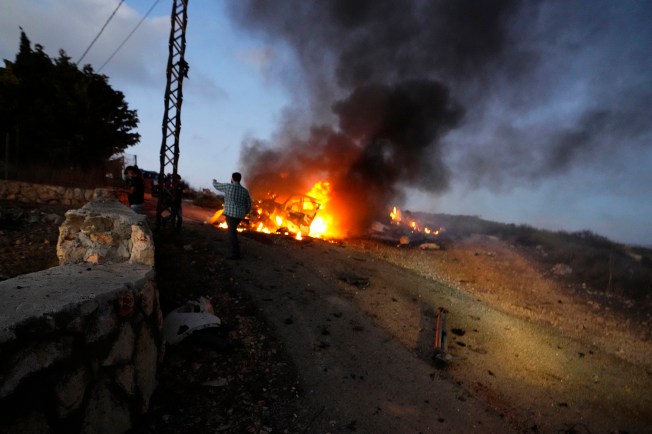
On October 13, the seven journalists from AFP, Al Jazeera, and Reuters got ready for another day of reporting on a quickly evolving conflict that began the week before, after the militant group Hamas attacked Israel. On Israel’s northern border and in south Lebanon, the Israeli military had been trading fire with Hezbollah, the militant Lebanese group, since October 8. That afternoon in south Lebanon, the journalists were mostly taking photographs and video of distant clashes. At around 4:45 p.m., they congregated in a clearing on a hilltop to cover a bombardment approximately 1.3 miles away.
The journalists took many security precautions. They all wore helmets and bulletproof jackets marked “Press.” The Reuters journalists had checked in with their security coordinator and shared their coordinates just before arriving.
“We were visible from above, with one of the cars marked as ‘TV,’ and we were visible to multiple Israeli military posts along the Israeli border, clearly marked as ‘Press,’” said Collins. “They knew we were there from the moment we arrived.”
Abdallah was killed instantly in the first strike that severely injured Assi, leaving her without feeling in her legs. Collins began to place a tourniquet on Assi’s leg to stop her bleeding, when the second Israeli tank shell struck the group.
“This [attack] changed my whole life,” Reuters’ Nazeh told CPJ. “Following that incident, I went through a mental crisis, not out of fear, but if that happened to me, what would happen to my kids, my life, my family? I wasn’t able to sleep at night. Why did all of that have to happen? We’re journalists. We’re not bearing any arms. Journalists report the news. They don’t make the news. This is known internationally. The journalist is supposed to be protected by all.”
“If you look at the facts of the attack – two strikes on the same target, 37 seconds apart, followed by nearly two minutes of .50 caliber weapon fire – it’s impossible to say it was a mistake.”
– Journalist Dylan Collins
Al-Sudani also spoke about the impact of the incident in an interview with CPJ; CPJ was unable to interview Joukhadar and Brakhya due to the recent escalation in Lebanon.
Audio analysis of footage from the attack by experts engaged by Human Rights Watch found that in the 25 minutes before the strike a drone circled the group 11 times. Amnesty International identified an Israeli Apache helicopter flying overhead before the attack in the footage captured by Al Jazeera, as well as in footage that an Al-Araby crew obtained from another location in Alma al-Chaab. Both indicate that Israel had the surveillance capacities to see the journalists.
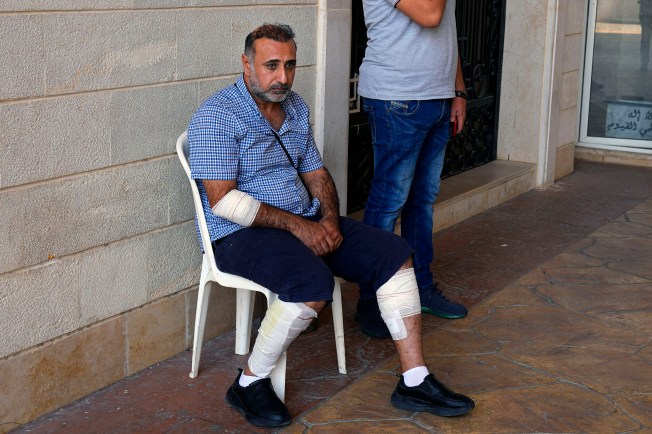 Iraqi Reuters journaist Thaer Al-Sudani, who was injured by Israeli shelling, attends an October 14, 2023, funeral procession for his colleague videographer Issam Abdallah, killed in the same shelling in southern Lebanon on October 13. (Photo: AP/Bilal Hussein)
Iraqi Reuters journaist Thaer Al-Sudani, who was injured by Israeli shelling, attends an October 14, 2023, funeral procession for his colleague videographer Issam Abdallah, killed in the same shelling in southern Lebanon on October 13. (Photo: AP/Bilal Hussein)A large munition fragment, now in the property of the Lebanese judiciary, was filmed and photographed next to Abdallah’s body. AFP had the images analyzed by six weapons experts who all concluded it was part of a 120-mm fin-stabilized tank shell, and that the Israeli army is the only military group in the region that uses this shell on its Merkava tanks.
The most recent civil society investigation into the attack, a March 2024 report by Netherlands Organisation for Applied Scientific Research (TNO), which was contracted by Reuters to analyze evidence, concluded not only that an Israeli tank crew fired two shells, but then “likely” opened fire on them with heavy machine gun fire for 1 minute and 45 seconds.
“If you look at the facts of the attack – two strikes on the same target, 37 seconds apart, followed by nearly two minutes of .50 caliber weapon fire – it’s impossible to say it was a mistake,” said Collins.
While the evidence points to deliberate Israeli fire, many questions remain unanswered for the journalists affected – chief among them, why?
“Was it a collective decision?” said Assi. “Was it a military decision? Was it a personal decision? Who was behind the attack? I want to know who chose to press that button and target us and kill Issam and change my entire life. I want to know the face, the name, something. Just something. Anything.”
Impunity persists
An IDF spokesperson told Reuters that the military is investigating the October 13 attack through the General Staff’s Fact Finding and Assessment Mechanism, which is the preliminary assessment process for an investigation.
After a “fact finding assessment” is completed it is referred to the Military Advocate General (MAG) to determine whether a criminal investigation is warranted. In May 2023, CPJ found that in the nine years that this assessment system had been in place, the MAG had never opened a criminal investigation into a journalist killing. The Office of the United Nations High Commissioner for Human Rights has called into question the independence and impartiality of the MAG, given its “dual role” in “investigating violations carried out in operations for which the MAG provided legal advice.”
Asked about the attack, the IDF told CPJ in an email that, “On October 13th, the Hezbollah terrorist organization fired at a number of locations along the Blue Line [which separates Lebanon from Israel and Israeli-occupied territory], including the firing of an anti-tank missile that hit the Israel security fence, adjacent to the community of Hanita. Immediately following the anti-tank missile launch, IDF soldiers suspected a terrorist infiltration into Israeli territory, and in response, used tank and artillery fire to prevent the infiltration. A number of hours later, a report was received that during the incident, journalists were injured in the area. The incident is under review.”
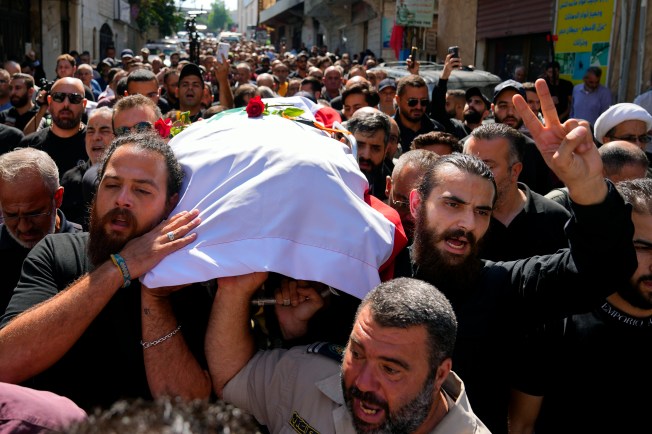 Mourners carry the body of Reuters videographer Issam Abdallah during a funeral procession in his hometown of Khiam, southern Lebanon, on October 14, 2023. (Photo: AP/Bilal Hussein)
Mourners carry the body of Reuters videographer Issam Abdallah during a funeral procession in his hometown of Khiam, southern Lebanon, on October 14, 2023. (Photo: AP/Bilal Hussein)As with the October 13 attack, in the majority of the cases cited in “Deadly Pattern,” journalists were clearly identified as members of the media or were inside vehicles with press insignia at the time of their deaths. In the report, CPJ found that the Israeli military often takes months or years to investigate killings and often discounts evidence and witness claims.
The Jerusalem Post reported that the MAG is looking into 300 suspected war crimes. CPJ wrote to the MAG in April 2024, requesting it to open a criminal investigation into the October 13 attack and other targeted killings, following a public statement by the MAG acknowledging that there have been cases of “unacceptable conduct” by the IDF in Gaza, some of which were being probed to determine if a criminal investigation was warranted. The MAG never responded or acknowledged receipt of the submission.
The International Criminal Court does not currently have authority to investigate the killing as neither Lebanon or Israel are members of the court, and nor has the U.N. Security Council referred the matter to the court to grant it jurisdiction.
Collins, a U.S. citizen, reported the attack to the U.S. embassy in Beirut while he was hospitalized recovering from injuries he sustained in the strike. He is the only survivor who holds citizenship in a country allied to Israel.
The U.S. has not announced an investigation into the attack. The U.S. was slow to investigate a similar high-profile incident, the 2022 killing of Palestinian-American journalist, Shireen Abu Akleh, who was murdered by the IDF while reporting from the Israeli-occupied West Bank city of Jenin.
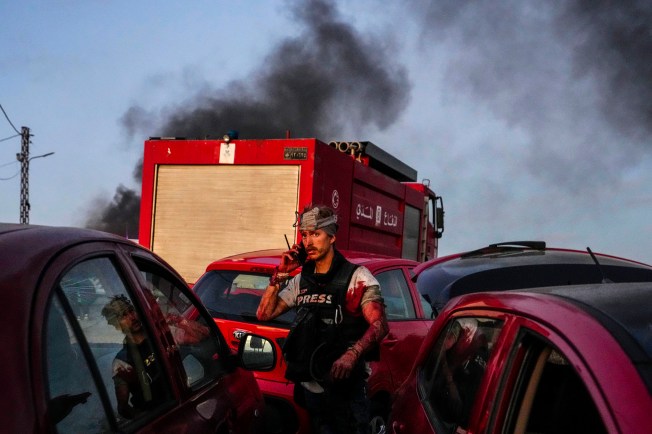
AFP journalist Dylan Collins speaks on his mobile phone after being injured by Israeli shelling in southern Lebanon on Oct. 13, 2023. The Israeli strikes, later determined to be targeted attacks, killed a Reuters videographer and wounded six other journalists.
(Photo: AP/Hassan Ammar)
In July 2022, President Biden declined a request from the Abu Akleh family to meet during his visit to Israel and the occupied West Bank. In an open letter to President Biden, the Abu Akleh family recounted their “grief, outrage and sense of betrayal” concerning the administration’s “abject response to the extrajudicial killing” of Abu Akleh. Subsequently, in July 2022, the family met with U.S. Secretary of State Antony Blinken in Washington about the case.
It is now nearly two years since the FBI launched its investigation into her case, yet there is still no timeline for its completion. Last month, Israeli troops reportedly tore down a banner of Abu Akleh in the occupied West Bank during a raid on Al Jazeera, her employer.
“I worry that what happened to us on October 13th, despite the overwhelming amount of visual evidence and physical evidence in the case, that it will fall into that same kind of deadly pattern, and that we will face that impunity and that it’ll be pushed aside and left,” Collins said.
“While Collins’ experience may not be widely known yet, the U.S. can chart a different course now. U.S. authorities have the opportunity to deliver swift and meaningful accountability in the aftermath of the October 13 lethal attack by the IDF on journalists by leading an immediate, independent, and transparent investigation that holds perpetrators to account,” said Ginsberg.
The campaign for justice
In July 2024, Assi carried the Olympic flame in Vincennes, France, honoring journalists killed while reporting, and was joined by Collins. “This is all for my best friend, Issam Abdallah, and all the other journalists who we have lost this year,” Assi said at the event. “This is all for them and to pay tribute and to honor them, to honor their memory. And I will keep Issam’s memory alive in everything I do. It’s all for him.”
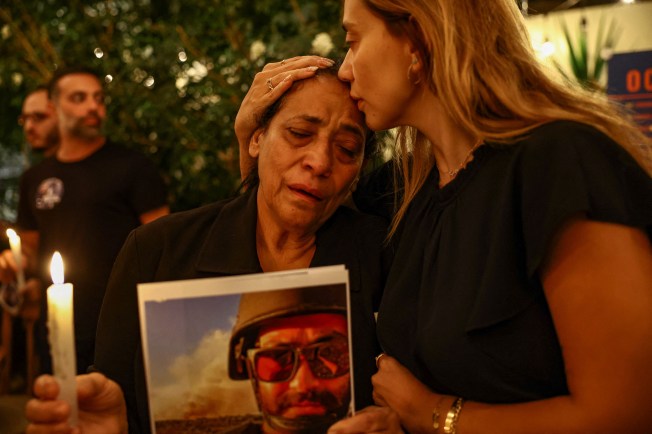 Abeer, sister of Issam Abdallah, who was killed in southern Lebanon during an Israeli air strike, holds her aunt during a candlelight vigil in Beirut on October 20, 2023. (Photo: Reuters/Amr Alfiky)
Abeer, sister of Issam Abdallah, who was killed in southern Lebanon during an Israeli air strike, holds her aunt during a candlelight vigil in Beirut on October 20, 2023. (Photo: Reuters/Amr Alfiky)Abdallah’s family is now seeking justice through international institutions. “Over nine months since Mr. Abdallah was killed, the IDF has not confirmed the conclusion of its inquiry, or any findings,” the family’s lawyers said in a July 23, 2024, announcement of a submission to the United Nations Independent International Commission of Inquiry on the Occupied Palestinian Territory, including East Jerusalem and Israel. The submission urges the commission to make recommendations to Israel to provide reparation to Abdallah’s family, and for both Israel and Lebanon to criminally investigate the circumstances of Abdallah’s killing and prosecute those responsible. Last month, CPJ along with 10 other press freedom and human rights organizations, urged the body to investigate and provide accountability Abadallah’s murder.
The lawyers for Abdallah’s family, some of the surviving journalists, as well CPJ and other partners, have also called for the full report of United Nations Interim Force in Lebanon’s investigation to be made public. According to Reuters, which saw a copy of the report, the peacekeepers concluded that the attack constituted both a breach of international law and United Nations Security Council Resolution 1701, the unanimously adopted resolution that sets out the terms of the permanent ceasefire to the 2006 Lebanon war.
At the time of the family’s filing to the commission, Abeer Abdallah, Abdallah’s sister, said of her brother’s murder, “The evidence is clear. There is no justification for it. And yet we are still waiting for justice for Issam, and for accountability. We will not rest until we achieve it.”
(Editor’s note: Paragraph 13 of this report has been updated to clarify the timeline of the exchange of fire between Israel and Hezbollah.)
Amelia Evans joined CPJ in December 2023. An international human rights lawyer by training, she spent more than a decade as the executive director of The Shifting Power Project (formerly known as the Institute for Multi-Stakeholder Integrity), a nonprofit human rights organization focused on rectifying power imbalances and abuses caused by corporations. Over the last 15 years, she has investigated and reported on business and human rights-related issues in a number of countries, particularly in the Central African and Asia-Pacific regions. Previously, she was a clinical supervisor at Harvard Law School’s International Human Rights Clinic, and has received numerous fellowships focused on economic justice and human rights. Evans obtained her LL.M. from Harvard Law School, and LL.B. (Hons.) and B.C.A. (Economics and Finance) from Victoria University of Wellington, New Zealand. In her other life, she is a documentary filmmaker.
Zoe Simbolon joined CPJ as senior communications associate in October 2022. Prior to CPJ, she served as communications specialist at Turning Point, an addiction research center based in Australia, leading communications on the advocacy campaign Rethink Addiction. Simbolon has also worked for Grameen America in the U.S., where she was responsible for media and communications, and has contributed to campaigns for organizations advancing asylum seeker and refugee rights and mental health policy. She holds a bachelor’s degree in communications from Victoria University and a graduate certificate in human rights from the University of Sydney.

 3 weeks ago
11
3 weeks ago
11
